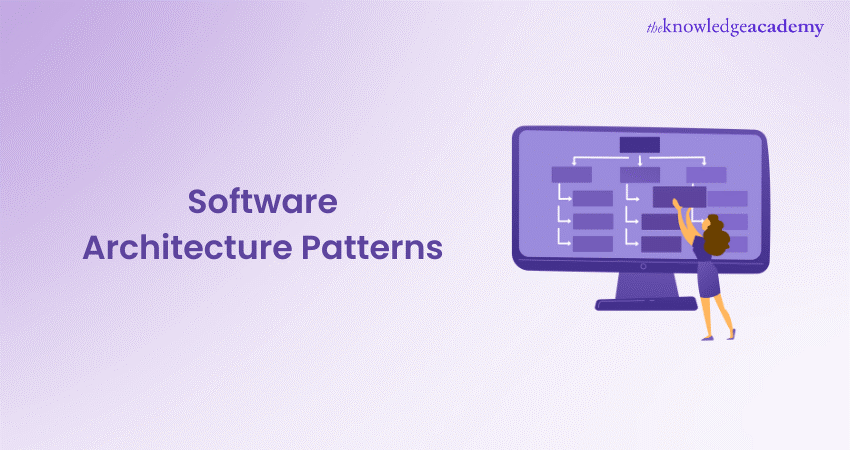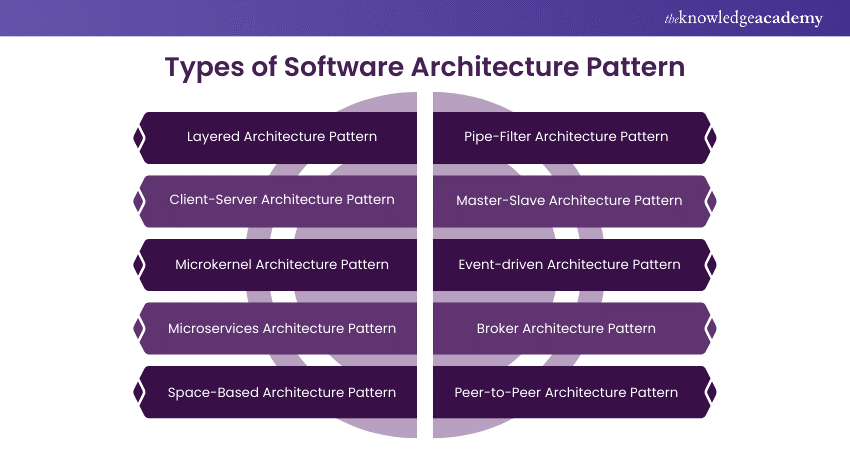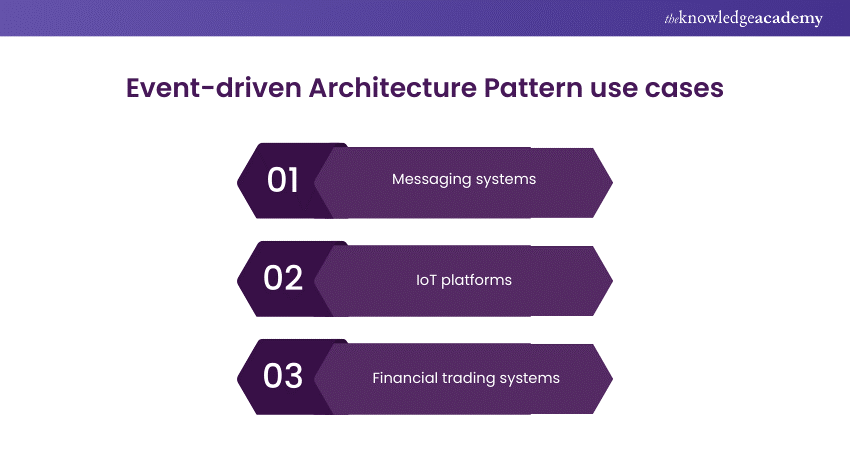We may not have the course you’re looking for. If you enquire or give us a call on +44 1344 203999 and speak to our training experts, we may still be able to help with your training requirements.
Training Outcomes Within Your Budget!
We ensure quality, budget-alignment, and timely delivery by our expert instructors.
- BCS Foundation Certificate in IS Project Management
- BCS Professional Certificate in Benefits Planning and Realisation
- BCS Foundation and Practitioner Certificate in Enterprise and Solution Architecture (Bundle Course)
- BCS Foundation Certificate in Digital Business Change Training
- BCS International Diploma in Business Analysis

In the world of software development, creating well-structured systems is crucial for success. A key element of achieving this is being aware of and making use of Software Architecture Patterns. These patterns provide solutions to common design challenges and direction on how to set up and construct software systems to satisfy needs and objectives. In this blog, we will explore different Software Architecture Patterns, their characteristics, and their applications in creating scalable software solutions.
Table of contents
1) What is Software Architecture?
2) Types of Software Architecture Pattern
a) Layered architecture pattern
b) Client-Server architecture pattern
c) Microkernel architecture pattern
d) Microservices architecture pattern
e) Space-Based architecture pattern
f) Pipe-Filter architecture pattern
g) Master-Slave architecture pattern
h) Event-driven architecture pattern
i) Broker architecture pattern
j) Peer-to-Peer architecture pattern
3) Difference Between Software Architecture Pattern and design pattern
4) Conclusion
What is Software Architecture?
Software Architecture is the blueprint of a software system. It is a plan that outlines how different parts of a software system will work together. It involves designing and organising the software components, including modules, layers, and interfaces. It helps to meet expectations and qualities such as scalability, reliability, and maintainability. Software Architecture serves as the skeleton for the entire software system, guiding its development and evolution.
Types of Software Architecture Pattern
Software Architecture Pattern is the reusable solution to a commonly occurring problem in Software Architecture design. These patterns offer guidelines and best practices for organising the structure and interactions of software components to achieve the required system qualities. Architecture Patterns help to design software systems that are adaptable and easier to understand. Here are some of the popular architectural patterns that have aided software companies in scaling up their businesses:

Layered architecture pattern
Layered Architecture is one of the most common types of Software Architecture Patterns. It organises the software system into multiple layers, each responsible for a distinct functionality. The layers are mostly arranged hierarchically and interact only with adjacent layers. The layers include the presentation layer, which handles user interaction; the business logic layer, which processes data; and the data storage layer, which connects with the database.
Client-Server architecture pattern
In this pattern, clients communicate with servers to obtain services over a network. Clients can be anything outside the server, whether through a web browser, mobile application, or desktop application. The server hosts and provides the expected facilities. These may include data storage and processing, application logic and presentation, business rules, and work. This pattern allows optimal utilisation of existing, centralised resources and management scalability, making it common in distributed computing environments.
Microkernel architecture pattern
Microkernel Architecture keeps things simple by keeping the core system functionality (microkernel) minimal and allowing extra features through plug-ins or modules. The microkernel provides essential services such as memory management, process scheduling, and inter-process communication. Plug-ins extend the system's functionality to meet requirements without changing the core. This pattern improves flexibility and adaptation to changing requirements.
Ace Your Next Interview with our top Software Testing Interview Questions!
Microservices architecture pattern
Microservices Architecture breaks down the application into small, separate services, each handling a single business function. It allows the teams to own, develop, deploy, and scale the services independently and without disrupting others. The services interact through lightweight protocols, like HTTP or messages. Each service can be made using different tools and languages. This pattern helps make the system flexible and able to handle big changes easily, making it ideal for complex and rapidly evolving systems.
Space-Based architecture pattern
Space-Based Architecture Is a distributed computing Architecture that circulates data across multiple nodes in a space-based manner. This helps make the system bigger and more stable. This pattern is commonly used in distributed caching systems, real-time analytics platforms, and high-performance computing environments. This is useful for systems that need to handle lots of data quickly.
Understand the concept of Business Change with our Business Change Course - join today!
Pipe-Filter architecture pattern
Pipe-filter Architecture is a data processing Architecture pattern where data flows through a series of components (filters) connected by pipes. Each filter performs specific operations on the data. The data flows constantly through the pipeline, with each filter processing the data and passing it to the next filter until the expected result. This pattern is ideal for applications such as compilers, data transformation pipelines and multimedia processing systems.
Master-Slave architecture pattern
In the Master-Slave Architecture, there is a single master node that coordinates many slave nodes to perform tasks. The master node gives jobs to slave nodes, gathers the results, and oversees the whole process. This pattern is used in distributed computing environments, parallel processing systems, and networked applications. It is ideal in situations where tasks need to be divided and executed in parallel for improved performance and scalability.
Event-driven architecture pattern

Event-driven Architecture is a pattern where components communicate and interact based on events. Events represent important changes or occurrences within the system that trigger responses from other components. It is used in messaging systems, IoT platforms, and financial trading systems.
Must-Know Automation Testing Interview Questions for Job Seekers!
Broker architecture pattern
Broker Architecture is a messaging Architecture pattern. It creates a central system that mediates communication between distributed systems or components. Producers send messages to the broker, which in turn sends them to the consuming unit. This pattern promotes loose coupling between producers and consumers. A broker-based system includes message queues, topics, and subscribers.
Peer-to-Peer architecture pattern
In Peer-to-Peer Architecture, all nodes within the network have the same capabilities and are equally responsible. Peers interact directly with one another, such as files or computing power, and do not require a mediator. This pattern enables peer discovery, resource sharing, and collaboration. It is suitable for decentralised systems, file-sharing networks, and collaborative applications.
Boost your knowledge in in Architect roles with our Enterprise and Solution Architecture Course- sign up now!
Difference Between Software Architecture Pattern and design pattern
Software Architecture Pattern focuses on a software system's high-level organisation and structure. It covers defining its overall layout and major components. It addresses fundamental design decisions and gives guidelines for organising the system's components and interactions to achieve qualities.
On the other hand, Design Pattern is smaller-scale solutions to common design problems within individual components or modules of the system. It addresses recurring design issues at a lower level. It offers solutions and best practices for implementing components of a software system, such as algorithms, data structures, or object interactions. It further enhances code reusability, readability, and maintainability.
Explore our Demo Website for Automation Testing now!
Conclusion
Understanding Software Architecture Patterns is essential for designing robust and scalable software systems. By exploring various Architecture patterns and their differences from Design Patterns, developers can make informed decisions to address challenges and requirements in software development.
Gain insights into the objectives of governance with our Architecture Concepts Course- sign up now!
Frequently Asked Questions

The best Software Architecture Pattern depends on the needs and requirements of each project. However, the layered architecture pattern is the most used Architecture design pattern.

Software Architecture Patterns provide solutions to common design problems. It offers guidelines and best practices for structuring and organising software systems. It improves system quality characteristics such as scalability, maintainability, and performance.

The Knowledge Academy takes global learning to new heights, offering over 30,000 online courses across 490+ locations in 220 countries. This expansive reach ensures accessibility and convenience for learners worldwide.
Alongside our diverse Online Course Catalogue, encompassing 17 major categories, we go the extra mile by providing a plethora of free educational Online Resources like News updates, Blogs, videos, webinars, and interview questions. Tailoring learning experiences further, professionals can maximise value with customisable Course Bundles of TKA.

The Knowledge Academy’s Knowledge Pass, a prepaid voucher, adds another layer of flexibility, allowing course bookings over a 12-month period. Join us on a journey where education knows no bounds.

The Knowledge Academy offers various Architecture Concepts and Domains Course including Business Analysis Course, Enterprise and Solution Architecture Course, Project Management Course and Agile Course. These courses cater to different skill levels, providing comprehensive insights into BCS Code of Conduct
Our Business Analysis Blogs covers a range of topics related to Scrum, offering valuable resources, best practices, and industry insights. Whether you are a beginner or looking to advance your Business Improvement skills, The Knowledge Academy's diverse courses and informative blogs have you covered.
Upcoming Business Analysis Resources Batches & Dates
Date
 BCS Foundation Certificate in Architecture Concepts and Domains
BCS Foundation Certificate in Architecture Concepts and Domains
Mon 9th Dec 2024
Mon 24th Feb 2025
Mon 30th Jun 2025
Mon 15th Sep 2025
Mon 10th Nov 2025







 Top Rated Course
Top Rated Course



 If you wish to make any changes to your course, please
If you wish to make any changes to your course, please


